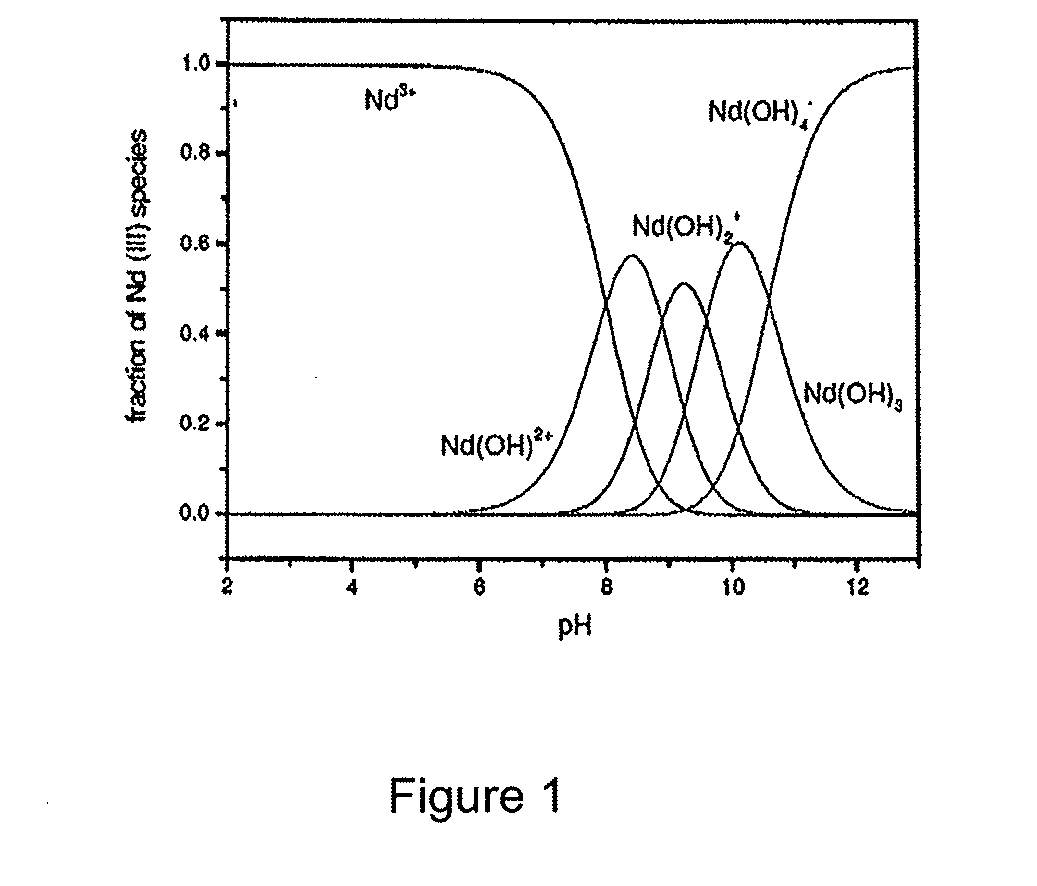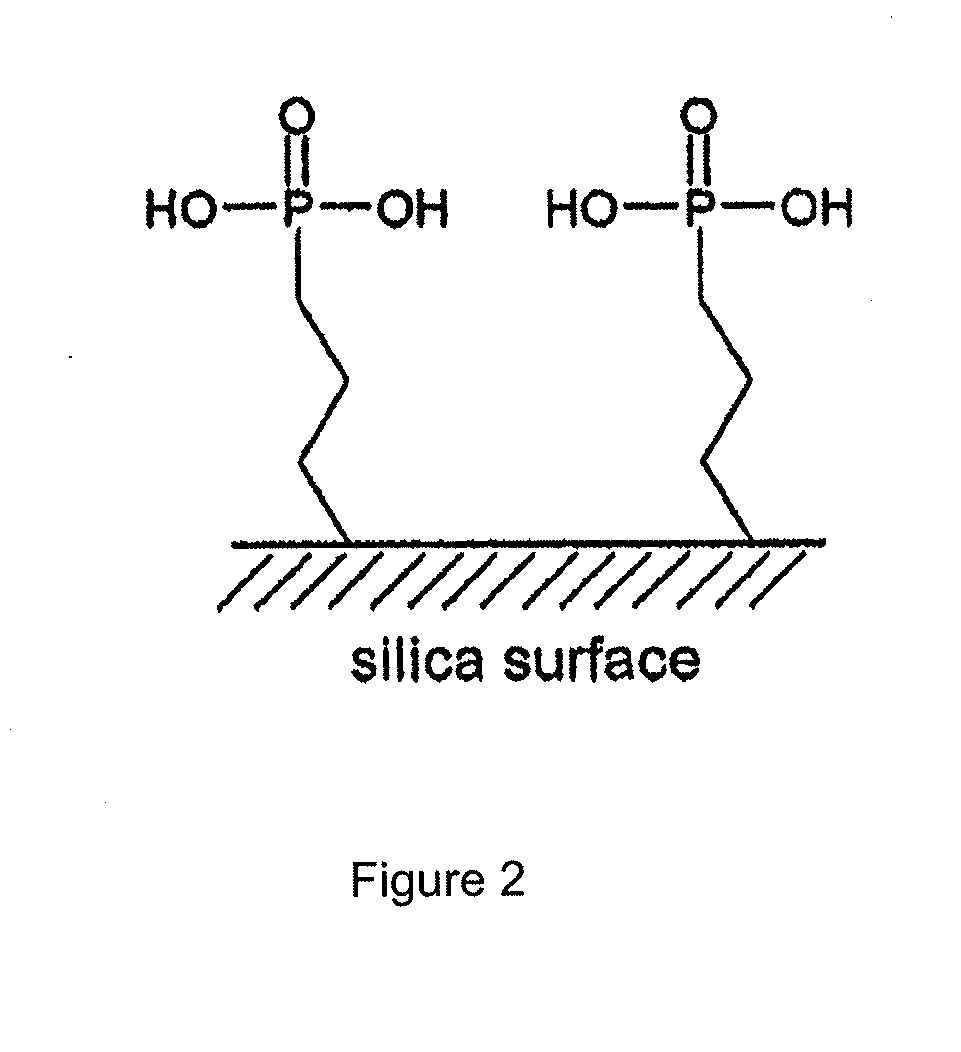Rare Earth Elements Separation Using Phosphorus Based Adsorbent
a technology of rare earth elements and phosphorus, which is applied in the direction of rare earth metal nitrates, yittrium oxides/hydroxides, lanthanide oxides/hydroxides, etc., can solve the problems of unavoidably generating secondary liquid waste, unable to show mechanical strength, and inability to chelate resins with limited applicability, etc., to achieve high acid stability, controlled pore size and distribution, and high capacity
- Summary
- Abstract
- Description
- Claims
- Application Information
AI Technical Summary
Benefits of technology
Problems solved by technology
Method used
Image
Examples
example 1
Background Theory—Distribution Equilibrium of Neodymium(III)
[0065]This Example describes aspects of the background theory of an embodiment of the present invention. The Evaluation of aqueous phase equilibrium concentrations of neodymium species using appropriate chemical reaction equilibrium analyses to understand the distribution of various forms of neodymium(III) ions in solution is described herein. The cations of neodymium are known to exist in the following forms depending on the pH of the aqueous solution. The proposed reaction mechanism following Baker, C. F.; Messmer, R. E., The Hydrolysis of Cations. John Wiley & Sons: Florida., 1986:
Nd3++H2ONd(OH)2++H+ log K=−8 (1)
Nd3++2H2ONd(OH)2++2H+ log K=−16.7 (2)
Nd3++3H2ONd(OH)3+3H+ log K=−26.5 (3)
Nd3++4H2ONd(OH)4−+4H+ log K=−37.1 (4)
[0066]The relative distribution of Nd(III) species in the aqueous solution calculated with the given thermodynamic constants is shown in FIG. 1. Neodymium ion species in the aqueous solution evaluated...
example 2
Materials and Reagents
[0084]This example describes the synthesis and preparation for characterization of an adsorbent of an embodiment of the present invention.
[0085]In one example, the adsorbent is a sol-gel material comprising clusters of phosphoric acid on the pore surface and silica backbone. Details of the adsorbent synthesis and structure are reported elsewhere and that synthesis procedure is employed here for adsorbent preparation (see Nam, K. H.; Tavlarides, L. L., Synthesis of a High-Density Phosphonic Acid Functional Mesoporous Adsorbent: Application to Chromium(III) Removal. Chem. Mater. 2005, 17, (6), 1597-1604.). This publication describes the synthesis of a high density phosphonic acid functional mesoporous adsorbent such as silyl-propyl-diethyl phosphonate (“SOL-PHONIC,” reproduced at FIG. 2 herein) by sol-gel processing. See also FIG. 3, which shows a schematic illustration of an organo ceramic adsorbent prepared by the sol-gel synthesis method (see Lee, J. S.; Gomez...
example 3
Characterization
[0090]This example describes the characterization of the adsorbent synthesized and prepared for characterization in the previous Example.
[0091]The effect of solution pH on metal ion adsorption at 25° C. is investigated using 1 mmol / L of neodymium concentration at pH in the range from 1 to 7. A 0.05M acetate buffer is used. The initial concentrations of neodymium (III) were 1 mmol / L, and the initial pH of the solution was adjusted by adding either NaOH or HNO3. The ionic strength of the solutions was less than 1.5×10−2 mol / L.
[0092]Equilibrium uptake capacities of the adsorbent are determined by contacting 0.02 g of adsorbent with 20 mL of Nd(III) solution buffered by 0.05M acetate at various initial concentrations (0.01-7.5 mmol / L) and pH (3.0, 4.5, and 6.0) at room temperature. The amount of adsorbed neodymium ions is calculated by a mass balance between the initial and equilibrium concentrations. Neodymium uptake rate of the adsorbent is performed in a batch mode wi...
PUM
| Property | Measurement | Unit |
|---|---|---|
| Volume | aaaaa | aaaaa |
| Volume | aaaaa | aaaaa |
| Volume | aaaaa | aaaaa |
Abstract
Description
Claims
Application Information
 Login to View More
Login to View More - R&D
- Intellectual Property
- Life Sciences
- Materials
- Tech Scout
- Unparalleled Data Quality
- Higher Quality Content
- 60% Fewer Hallucinations
Browse by: Latest US Patents, China's latest patents, Technical Efficacy Thesaurus, Application Domain, Technology Topic, Popular Technical Reports.
© 2025 PatSnap. All rights reserved.Legal|Privacy policy|Modern Slavery Act Transparency Statement|Sitemap|About US| Contact US: help@patsnap.com



